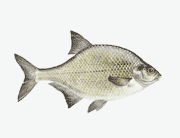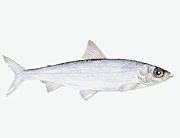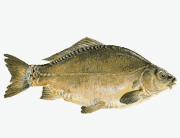|
|
|
 Pike
Pike (Sw: Gädda)
The pike has a long slender body, a large
head, and a wide mouth full of sharp teeth.
Its dorsal fin is located towards the
tail. The fish is yellowy-green in colour
with a dark back and light spots along its
sides.
The pike found in Swedish waters
generally weigh between 1-4 kg, although
pikes can weigh up to 34 kg and
grow up to 1.5 metres long. The female
of the species is significantly larger than
the male.
The pike is a predatory fish
and feeds exclusively on other fish, and
occasionally other pike. They usually
hide themselves and lie in wait until
their prey passes sufficiently close for
them to unleash a savage attack.
Pike can be found in nearly every
lake and river in Sweden, and particularly
like clumps of reeds and shallow waters
near to the riverbank. The best seasons
to fish for pike are autumn, winter
and spring.
|
|
|
|
|
|
|
|
|
|
 Perch
Perch (Sw: Abborre)
The perch is easy to recognise from the
dark bands that decorate its sides and its
characteristic red pelvic fins.
The colour
of the perch varies from light green to
almost black depending on the sort of
water it lives in.
The female is larger
than the male and perch have been
knownto weighup to 4.7 kg and growup
to 51 cm long. However, in our waters
they rarely weigh more than 0.5 kg.
The perch is the most commonly occurring
species in Sjuhärad.
It is a shoaling
fish when young but as it grows older
and becomes larger it is often found
alone.
The best seasons to fish for perch
are autumn and winter.
Perch taste best
when they weigh under a kilo.
|
|
|
|
|
|
|
|
|
|
 Pike-perch
Pike-perch(Sw: Gös)
The pike-perch is recognisable by its
elongated body and dark linear markings
on its sides. Above these lines the
pike-perch is grey coloured with tinges
of brown and green. Its sides are silvery
or grey and its abdomen white. Its light
coloured dorsal fin has large black spots
and sharp spines.
Pike perch can grow
up to 130 cm long and weigh up to 15 kg,
but fish weighing between 0,7–3 kg are
commonest in our waters.
The
pike-perch is a predatory fish which has
adapted to hunting by use of its sharp
senses.
The pike-perch can be found in a
number of Sjuhärad’s lakes, and likes
murky and nutrient rich waters best. It
lives a solitary life and stays away from
the water’s edge.
It is best to fish for pike-
perch in autumn and winter, when
it is cold and they go down into the deep
water. The firm, lean meat of the
pike-perch makes it one of the most delicious
fresh water fish.
Up to top
|
|
|
|
|
|
|
|
|
|
 Rainbow Trout
Rainbow Trout
(Sw: Regnbåge)
The rainbow trout is a member of the
salmon family originally from the west
coast of America, but which has now
spread over large parts of the world.
Its
most recognisable feature is the broad
red-violet rainbow band that runs along
its side and from which it gets its name.
Rainbow trout can weigh up to 15 kg and
grow up to 80 cm long, but ‘wild’ rainbow
trout normally weigh under 1 kg
(although farmed trout can weigh
more). Rainbow trout are rarely over 5
kg in weight.
This species was introduced to Sweden
in the 1890s and all the rainbow
trout found in a wild state in Swedish
waters have been reared in hatcheries
for the purposes of sport fishing. There
are hatcheries across Sweden, both in
fresh and salt waters.
The rainbow trout
tastes similar to salmon, and the colour
of its meat can vary from light brown to
pink, red or almost white.
Up to top
|
|
|
|
|
|
|
|
|
|
 Trout
Trout (Sw: Öring)
The trout is generally silvery with a green
or brownish back, black and red spots
along the sides and often a yellowy
underside.
Trout can vary greatly in appearance
and size depending on their
species but have been known to weigh
up to 50 kg and grow to over a metre in
length. In Swedish waters they generally
reach a weight of around 15 kg.
Trout species are generally classified
according to their habitat and can migrate
to the sea or live in lakes, rivers or
streams. Various species of trout can be
found throughout Sweden including
sea trout, lake trout and brown trout.
The trout is a good edible fish with light
and tasty, often red, meat.
Up to top
|
|
|
|
|
|
|
|
|
|
 Tench
Tench (Sw: Sutare)
The tench can be recognised by its bronze
coloured, seasonally jet black, body
with small fine scales. The tench’s greenish
pectoral fins are located close to the
head and small barbels protrude from
the corners of its mouth.
Tench can
weigh up to 9 kg, but in Swedish waters
they normally reach around 70 cm in
length and 4.8 kg in weight.
The tench is common in Sweden’s
southern and central lakes, and is often
found close to the bottom amongst the
murky waters and vegetation in which
it finds its nourishment.
It is best to fish
for tench in autumn. It is a fine edible
fish.
Up to top
|
|
|
|
|
|
|
|
|
|
 Roach
Roach (Sw: Mört)
The roach is a brilliant silver colour with
red fins and red eyes.
The species can vary in size but is commonly around 20
cm long and rarely weighs more than 0.5
kg.
It is one of the most common freshwater
fish in Sweden and can be found
in nearly every part of the country.
Roach can be found swimming in shoals
in various parts of the lake.
The roach is
not considered an edible fish in Sweden
but is widely used as bait or as hen or fish
feed.
Up to top
|
|
|
|
|
|
|
|
|
|
 Sea Trout
Sea Trout (Sw: Havsöring)
The Sea trout has many similarities to the salmon in appearance. The difference between these species is the sea trout’s more spotted body.
In Swedish waters they generally reach a length of 110 cm and reach a weight of around 15 kg.
The sea trout can be found in both small and big rivers and particularly like shallow waters. A juvenile sea trout feeds on insects and molluscs, when running back to the sea they feed on other fish instead.
Up to top
|
|
|
|
|
|
|
|
|
|
 Common bream
Common bream
(Sw: Braxen)
Braxen har en samman- tryckt kropp och rygg- puckel. Munnen är liten men kan skjutas ut när fisken letar efter mat. Alla fenor är mörkgrå och stjärtfenan är djupt kluven. Färgen är gråsvart högst upp på ryggen men kan skifta till grönsvart. Sidorna är mässing- eller silverfärgade beroende på var den lever.
Braxen växer långsamt och det tar 7-8 år innan den väger ett kilo. Den kan nå en vikt av 11,5 kg och bli 75 cm. Vanligtvis ligger vikten på ca 1-2 kg i svenska vatten.
Braxen är vanlig i Sjuhärads sjöar och åar.
Fiskköttet anses gott men är rikt på ben. Bästa säsong är på hösten. Braxen är en uppskattad sportfisk.
Up to top
|
|
|
|
|
|
|
|
|
|
 Burbot
Burbot (Sw: Lake)
Laken är en sötvattens- fisk med skäggtöm under hakan. Den känns igen på sin långsträckta kropp och relativt breda huvud. Den har två ryggfenor, en främre kortare och en långsträckt bakre ryggfena. Färgen är grå- eller brunsvart på ryggen med ljusare, fläckiga sidor. Huden känns som läder men är täckt av små fjäll.
Laken kan bli upp till 1,2 m lång och väga 24 kg. Vanligtvis ligger vikten på 0,5-1,5 kg i våra vatten.
Laken är en kallvattenfisk som trivs i djupa, kalla och syrerika sjöar. Fisken äter mest under den kalla perioden av året och om sommaren är den aktiv under natten.
Laken har ett gott, välsmakande kött och rom. Bästa säsong att fånga fisken är på vintern.
Up to top
|
|
|
|
|
|
|
|
|
|
 European Eel
European Eel (Sw: Ål)
The eel has a snake-like body and its
dorsal and anal fins are combined into a
single fin that runs along the back of the
body. The eel has no pelvic fin and its
very fine scales are deeply imbedded in
its skin. Its colour depends on its stage of
development, but when fully grown it
has a black back and yellow or white abdomen.
The female is the largest of the
sexes and can weigh up to 5 kg and grow
up to 1.5mlong. The male only ever reaches
30–50 cm in length.
The eel can be found in almost all of
Sweden. It is best to fish for eel between
April and December, but it is also farmed
and can therefore be eaten all year
round. It is considered a great delicacy.
Although the eel can be eaten and is
present in many of Sjuhärad’s lakes,
Marketplace 7-härad recommends that
you think carefully before removing
any eels from the water, as the global eel
population currently lies below what
many consider a biologically safe limit.
Read more
Up to top
|
|
|
|
|
|
|
|
|
|
 Lake Whitefish
Lake Whitefish (Sw: Sik)
Siken tillhör laxfiskarna men påminner om sill. Det är en långsträckt fisk med silvriga sidor, ljus buk och mörk rygg. Siken har en ganska liten mun med överbett, stjärtfenan är djupt kluven. På bakre delen av ryggen har den laxfiskarnas karaktäristiska fettfena. I Sverige förekommer flera olika sikarter som kan vara svåra att skilja åt. De större sikarna, stor- och älvsik brukar väga 1-2 kg, men kan väga upp till 7-8 kg.
Siken förekommer i så gott som hela landet i sjöar, älvar och längs syd- och ostkusten. Sik är en stimfisk, föredrar kallt vatten och förekommer gärna i stora djupa sjöar. Småsikar äter bottendjur till att börja med och övergår senare med att äta annan fisk.
Sik är en delikatess och färgen är med några få undantag alltid vitt. Rommen används till kaviar. Den bästa fångstperioden är mars-september.
Up to top
|
|
|
|
|
|
|
|
|
|
 Vendace
Vendace (Sw: Siklöja)
Vendace is a small glossy fish, confusingly
similar to the herring but with the fat fins characteristic of salmonids.
It’s underbite separates it from the larger
lake whitefish which has an overbite.
Its back can be grey or shimmering
green, whilst its belly is silver coloured.
Vendace can grow up to 45 cm long and
weigh up to 1 kg, but in our waters they
average around 20 cm and 100 g.
Vendace is both a fresh and saltwater
fish and occurs in the clear waters of
southern and central Sweden. Vendace
is a typical shoaling fish and prefers colder
waters.
Marknadsplats 7-Härad and Sassis Resor 7-Härad recommends
against fishing for Vendace as the species
is internationally classified as acutely
threatened and is on both the Swedish
Board of Fisheries list, and the World
Conservation Union’s (IUCN) red list,
as a threatened species.
Up to top
|
|
|
|
|
|
|
|
|
|
 Common Carp
Common Carp (Sw: Karp)
The carp has a high, short and somewhat compressed body shape. The dorsal fin is elon-
gated, the tail-end powerful. On its upper lip it has two barbels as well as one in each corner of the mouth. Its normal colour is either green-grey or brass. The carp, which is considered to be very tasty, was brought to Sweden by the monks in the 16th century. It can weigh up to 30 kg and grows to 100 cm in length. Its normal weight in Swedish waters is around 3 kg.
The carp, which is the world’s most farmed fish, lives in the south and midland areas of Sweden in calm rivers and warm reservoirs (preferably 15 to 25° C) with rich underwater vegetation. It is a tenacious fish, and is able to live in water with a low level of oxygen. The carp feeds on both vegetation and animals, which means it eats seeds and algae, but also insects, molluscs, mussels and shellfish. The fish is shy and usually gathers its food at night.
Commercial fishing of carp does not take place in Sweden since it is a farmed fish and an angling fish, which has been planted into the water. The carp is good all year round.
Up to top
|
|
|
|
|
|
|
|
|
|
The above text is from the organisation
Svensk Fisk, a trade organisation that
promotes fish and seafood products.
Homepage, also in English:
www.svenskfisk.se.
The text has been
amended by Marknadsplats
7-Härad and Sassis Resor 7-Härad to reflect
local conditions in the Sjuhärad region.
Fish drawings: Calle Bergil.
Till sidans topp
|
|
|
|
|
|
|
|
|


